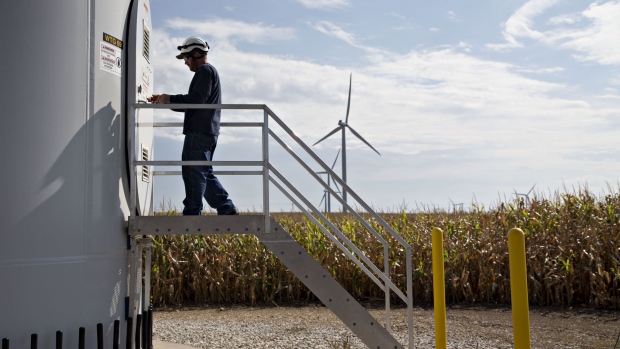Feb 4, 2021
Experts Tell Biden: Your Climate Goals Require a Carbon Price
, Bloomberg News

(Bloomberg) -- Meeting the climate goals of President Joe Biden will require setting a national cost for carbon pollution and spending heavily on social programs to assist Americans hurt by the clean-energy transition. Those are the findings in a new report from the National Academies of Sciences, Engineering, and Medicine, the latest group to lay out a detailed strategy for making the U.S. economy carbon-neutral by 2050.
The goal to be carbon-neutral by mid-century — which the global scientific community says is the only way to avert the worst effects of climate change — has been widely embraced in the private sector and by nine of the top 10 biggest economies, including the U.S. Yet 30 years is very little time to wind down and replace an energy system that's taken generations to build. Urgent steps and market signals are needed, the report said, such as a mechanism to place a price on carbon emissions.
“The big difference between this and any previous report is the attention paid to the social connections to the equity and diversity, and community worker-protection issues,” said Stephen Pacala, committee chair and a professor of ecology and evolutionary biology at Princeton University. “The report was specifically created to have a full representation of the social dimensions of a transition like this. At least half of our policy recommendations are in that camp.” One of their suggestions is to establish a White House Office of Equitable Energy Transitions to develop criteria to ensure that energy transition funds are equitably shared so that historically marginalized communities can benefit from new jobs and low-cost net-zero energy.
Federal officials are at the receiving end of several firehoses of expertise specifying what, exactly, needs to be done to put the U.S. economy on a climate-safe footing by mid-century.
There’s a map of what federal agencies should do. There’s a database of job-creating policy ideas. Princeton researchers in December illustrated five decarbonization scenarios for the 2020s that could leave the U.S. well-positioned to meet the world’s science-driven mid-century deadline. There’s “quiet climate policy,” whose clean investments steadily pay off at epic scale. A research team concluded last month that the U.S. “can reach zero emissions without requiring changes to behavior. Cost is about $1 per person per day, not counting climate benefits.” The Decarb America project today reported that its incremental cost estimates “are small relative to the projected size of the U.S. economy, constituting only 0.4-2.2% of GDP,” compared with 5% to 10% for the volatile traditional energy system.
Above all, time is of the essence: An analysis published Wednesday by Energy Innovation Policy & Technology LLC, a nonpartisan energy and environmental policy research firm, concludes that delaying decarbonization from today until 2030 would raise the overall cost of energy capital, operations, and fuel by 72%. The time-crunch forces industries to make more draconian changes more quickly, including more aggressive pushes, for example, into building efficiency and expensive technologies that captures CO₂ directly from air.
The new National Academies report argues that carbon pricing, the politically unpopular idea of taxing emissions or requiring permits, is an important step to meet the 2050 goal. It is also not enough. The authors, drawn from numerous fields of research and experience, also compiled a list of emissions-reduction policies that include electrifying vehicles and appliances. These technological accomplishments must be matched with complementary efforts to ensure that the energy transition isn’t too hard on any U.S. communities, particularly historically marginalized and poor areas.
Yet slashing emissions requires more than a technical transition, the report suggests. The report calls for the creation of a National Transition Corporation to manage problems like possible job loss and equitable access to economic opportunities created by infrastructure development. It estimates the cost at $20 billion over 10 years, which would require Congressional approval.
The National Academies emphasized just how critical the next 10 years are for government action. To reach carbon neutrality, industry and the private sector will have to electrify. That's why it's so urgent, the report says, for the government to invest heavily in systems that will allow the rest of society to follow suit.
The report outlines the immense technical challenges to achieving the basic milestones for decarbonizing in a timely manner. For example, Biden says he wants to decarbonize the U.S. electric grid by 2035. The academies suggest that the grid needs to be 75 percent carbon free by 2030. But to achieve that, they note, “would require an average pace of wind and solar installation that each year matches or exceeds the record historical yearly deployment of these technologies.” And that pace would have to accelerate every year from 2025 to 2030.
But the biggest challenges may be the policy imperatives that need bipartisan support to implement. There is currently little political appetite on either side of the aisle for a carbon tax starting at $40 per ton as suggested by the report — which is still below data-driven estimates of what every ton of CO₂ costs society. Carbon pricing would likely take an act of Congress, as would the academies’ suggestion that the Department of Energy set manufacturing standards to achieve close to 100 percent all-electric appliances by 2050.
©2021 Bloomberg L.P.


